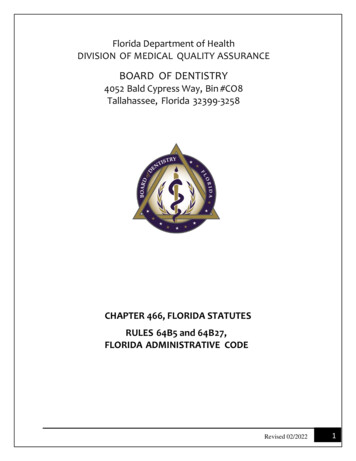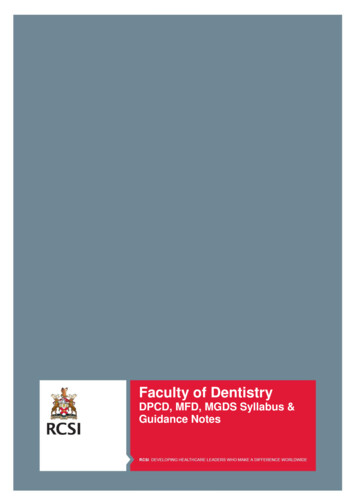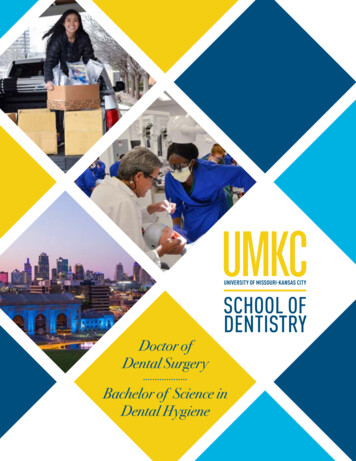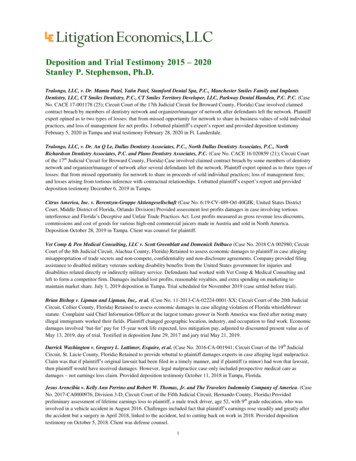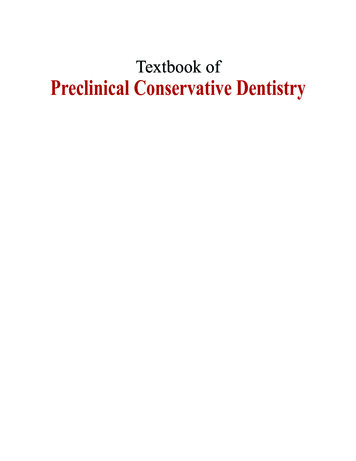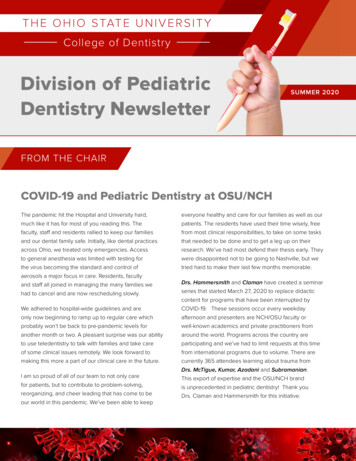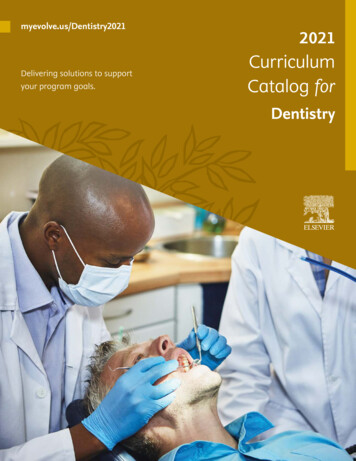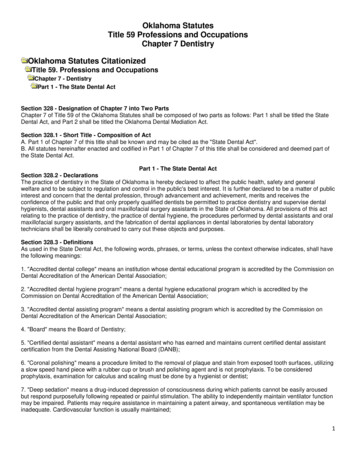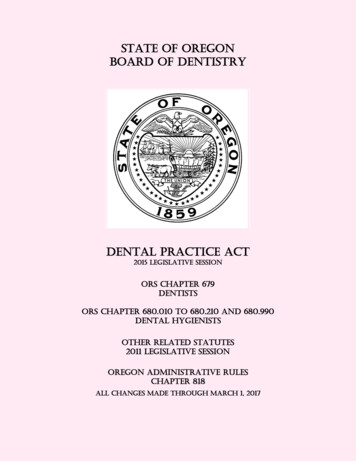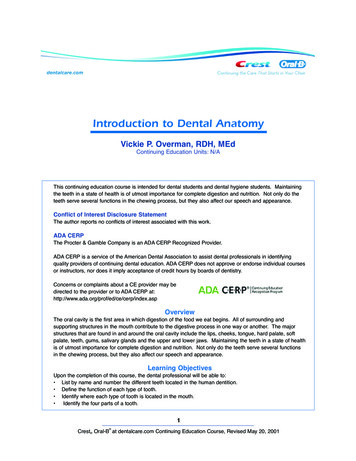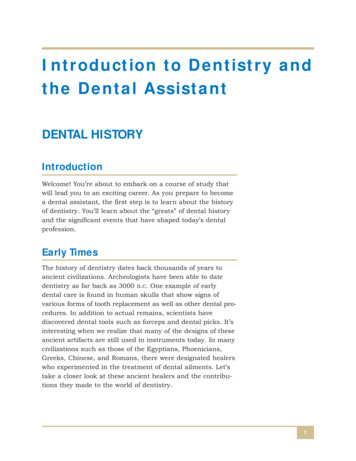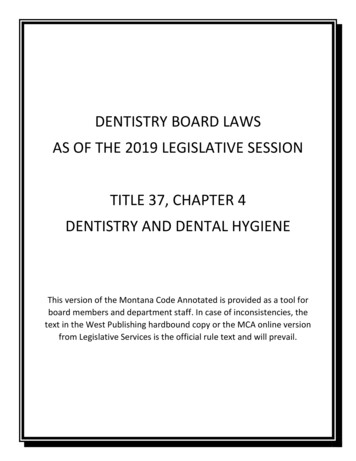
Transcription
DENTISTRY BOARD LAWSAS OF THE 2019 LEGISLATIVE SESSIONTITLE 37, CHAPTER 4DENTISTRY AND DENTAL HYGIENEThis version of the Montana Code Annotated is provided as a tool forboard members and department staff. In case of inconsistencies, thetext in the West Publishing hardbound copy or the MCA online versionfrom Legislative Services is the official rule text and will prevail.
CHAPTER 4DENTISTRY AND DENTAL HYGIENEChapter Cross-ReferencesProfessional service corporations, Title 35, ch. 4.General provisions relating to health care practitioners, Title 37, ch. 2.Limitations on dentistry and oral surgery practices involving general anesthesia, 37-4-511.Denturitry, Title 37, ch. 29.Validity of consent to medical treatment, Title 41, ch. 1, part 4.Dentist to report child abuse, 41-3-201.Duty of dentist to report violation of Montana Elder and Persons With Developmental DisabilitiesAbuse Prevention Act, 52-3-811.Chapter Administrative RulesTitle 24, chapter 138, ARM Board of Dentistry.ARM 24.138.2301 Unprofessional conduct.Part 1General37-4-101. Definitions — practice of dentistry. (1) Unless the context requires otherwise, in thischapter, the following definitions apply:(a) "Board" means the board of dentistry provided for in 2-15-1732.(b) "Deep sedation" means a drug-induced depression of consciousness during which patientscannot be easily aroused but respond purposefully following repeated or painful stimulation. The ability toindependently maintain ventilatory function may be impaired. Patients may require assistance inmaintaining a patent airway, and spontaneous ventilation may be inadequate. Cardiovascular function isusually maintained.(c) "Department" means the department of labor and industry provided for in Title 2, chapter 15,part 17.(d) "General anesthesia" means a drug-induced loss of consciousness during which patients arenot arousable, even by painful stimulation. The ability to independently maintain ventilatory function isoften impaired. Patients often require assistance in maintaining a patent airway, and positive pressureventilation may be required because of depressed spontaneous ventilation or drug-induced depression ofneuromuscular function. Cardiovascular function may be impaired.(2) Except for the provisions of 37-4-104, a person is practicing dentistry under this chapter if theperson:(a) performs, attempts, advertises to perform, causes to be performed by the patient or any otherperson, or instructs in the performance of dental operations, oral surgery, or dental service of any kindgratuitously or for a salary, fee, money, or other remuneration paid or to be paid, directly or indirectly, tothe person, any other person, or any agency;(b) is a manager, proprietor, operator, or conductor of a place where dental operations, oralsurgery, or dental services are performed, unless the person is the personal representative of the estateof a deceased dentist or the personal representative of a disabled dentist, as provided in 37-4-104;(c) directly or indirectly, by any means or method, furnishes, supplies, constructs, reproduces, orrepairs a prosthetic denture, bridge, appliance, or other structure to be worn in the human mouth;(d) places the appliance or structure in the human mouth or attempts to adjust it;(e) advertises to the public, by any method, to furnish, supply, construct, reproduce, or repair aprosthetic denture, bridge, appliance, or other structure to be worn in the human mouth;
(f) diagnoses, professes to diagnose, prescribes for, professes to prescribe for, treats, orprofesses to treat disease, pain, deformity, deficiency, injury, or physical condition of human teeth, jaws,or adjacent structures;(g) extracts or attempts to extract human teeth or corrects, attempts, or professes to correctmalpositions of teeth or of the jaw;(h) gives or professes to give interpretations or readings of dental roentgenograms;(i) administers an anesthetic of any nature, subject to the limitations provided in 37-4-511, inconnection with a dental operation;(j) uses the words "dentist", "dental surgeon", or "oral surgeon", the letters "D.D.S." or "D.M.D.",or any other words, letters, title, or descriptive matter that in any way represents the person as being ableto diagnose, treat, prescribe, or operate for any disease, pain, deformity, deficiency, injury, or physicalcondition of human teeth, jaws, or adjacent structures;(k) states, advertises, or permits to be stated or advertised, by sign, card, circular, handbill,newspaper, radio, or otherwise, that the person can perform or will attempt to perform dental operationsor render a diagnosis in connection with dental operations; or(l) engages in any of the practices included in the curricula of recognized dental colleges.History: (1)En. 66-901.1 by Sec. 77, Ch. 350, L. 1974; Sec. 66-901.1, R.C.M. 1947; (2)En. Sec. 10, Ch. 48, L. 1935; re-en.Sec. 3115.10, R.C.M. 1935; amd. Sec. 2, Ch. 38, L. 1941; amd. Sec. 3, Ch. 34, L. 1961; amd. Sec. 5, Ch. 352, L. 1969; amd.Sec. 83, Ch. 350, L. 1974; Sec. 66-910, R.C.M. 1947; R.C.M. 1947, 66-901.1, 66-910(1); amd. Sec. 3, Ch. 274, L. 1981; amd.Sec. 4, Ch. 363, L. 1981; amd. Sec. 1, Ch. 518, L. 1985; amd. Sec. 1, Ch. 151, L. 1997; amd. Sec. 113, Ch. 483, L. 2001; amd.Sec. 5, Ch. 100, L. 2011.Compiler's Comments2011 Amendment: Chapter 100 in (1) deleted former definition that read: ""Conscious sedation"means a minimally depressed level of consciousness in which the patient breathes normally withoutassistance, retains protective reflexes, and responds to physical stimulation or verbal command in amanner appropriate to the patient's cognitive level. Conscious sedation is not a form of generalanesthesia, and brief interludes of unconsciousness during conscious sedation do not bring conscioussedation within the scope of general anesthesia"; inserted definition of deep sedation; in definition ofgeneral anesthesia substituted current text for "means a state of unconsciousness intentionally producedby anesthetic agents, with absence of pain sensation over the entire body and a greater or lesser degreeof muscular relaxation. The drugs producing this state can be administered by inhalation, intravenously,intramuscularly, or via the gastrointestinal tract. General anesthesia is divided into:(i) full general anesthesia, which means a level of consciousness in which the patient is withoutintact protective reflexes, is unable to maintain an airway, and is incapable of rational response to queryor command; and(ii) light general anesthesia, which means a level of consciousness in which the patient breathesnormally without assistance and retains protective reflexes throughout most of the procedure"; anddeleted definition that read: ""General anesthetic" means any recognized anesthetic agent, sedative,hypnotic, tranquilizer, or narcotic used in sufficient prescribed dosages for the purpose of inducinggeneral anesthesia.(ii) The term does not include a nitrous oxide and oxygen mixture or any other anestheticadministered to produce conscious sedation". Amendment effective October 1, 2011.2001 Amendment: Chapter 483 in definition of department substituted reference to department oflabor and industry for reference to department of commerce and substituted "part 17" for "part 18"; andmade minor changes in style. Amendment effective July 1, 2001.1997 Amendment: Chapter 151 in (2), at beginning, inserted exception clause; in (2)(b), at end,inserted exception for personal representatives; and made minor changes in style.1985 Amendment: Inserted (1)(c) through (1)(e) defining conscious sedation, general anesthesia,and general anesthetic; and in (2)(i) after "nature", inserted "subject to the limitations provided in37-4-511".1981 Amendments: Chapter 274 substituted "department of commerce" for "department ofprofessional and occupational licensing" in (1)(b); changed internal references to the department and theboard.Chapter 363 changed "board of dentists" to "board of dentistry" in (1)(a).Cross-ReferencesExemptions from physician's licensing requirements, 37-3-103.
Administrative RulesARM 24.138.301 Definitions.ARM 24.138.306 Teeth whitening.Law Review ArticlesDental Malpractice: Under a Microscope, Toto, 142 Chi. Daily Bull. S14 (1996).Products Liability Law and the Dental Profession, Harold, 43 Med. Trial Tech. Q. 117 (1996).HIV and Dentistry, Lawyer, 29 Valparaiso U.L. Rev. 297 (1994).A Primer on Dental Litigation, Pekarsky, 22 Trial Law. Q. 45 (1992).37-4-102. Designations constituting prima facie evidence of practicing dentistry. Except for theprovisions in 37-4-104, appending the word "dentist" or the letters "D.D.S.", "D.M.D.", or similar letters toa person's name on a door or a sign, in a printed or published form, or in any other type of advertisementis prima facie evidence that the person is engaged in the practice of dentistry and is subject to theregulations, convictions, and penalties of this chapter.History: En. Sec. 12, Ch. 48, L. 1935; re-en. Sec. 3115.12, R.C.M. 1935; R.C.M. 1947, 66-912; amd. Sec. 2, Ch. 151, L.1997.Compiler's Comments1997 Amendment: Chapter 151 at beginning inserted exception clause; after "a person's name"substituted current language regarding various advertising forms for "in any way for advertising or uponany door or sign or upon or in any writing or print, publish, or use the same in any way or cause either ofthe same to be done"; and made minor changes in style.37-4-103. Exemptions. (1) A dental laboratory or dental technician is not practicing dentistry underthis chapter when engaged in the construction, making, alteration, or repairing of bridges, crowns,dentures, or other prosthetic appliances, surgical appliances, or orthodontic appliances if the casts,models, or impressions on which the work is constructed have been made by a regularly licensed andpracticing dentist and the crowns, bridges, dentures, prosthetic appliances, surgical appliances, ororthodontic appliances are returned to the dentist on whose order the work was constructed.(2) Section 37-4-101(2) and part 5 of this chapter do not apply to a legally qualified physician or toa dental surgeon employed by the United States government or to a legally licensed health carepractitioner of another state making a clinical demonstration before a dental society, convention, orassociation of dentists or to a licensed dental hygienist performing an act authorized under 37-4-401 or37-4-405.(3) This chapter does not prevent a bona fide faculty member of a school, college, or departmentof a university recognized and approved by the board from performing dental procedures necessary tothe faculty member's teaching functions. This chapter does not prevent students from performing dentalprocedures under the supervision of a bona fide instructor of a school, college, or department of auniversity recognized and approved by the board if the dental procedures are a part of the assignedteaching curriculum.(4) This chapter does not prohibit or require a license with respect to the practice of denturitryunder the conditions and limitations defined by Title 37, chapter 29. The provisions of this chapter do notapply to a person engaged in the lawful practice of denturitry.(5) This chapter does not require the licensure of or prohibit the personal representative of theestate of a deceased dentist or the personal representative of a disabled dentist from contracting with adentist to manage the dental practice at an establishment where dental operations, oral surgery, or dentalservices are provided if the personal representative in either case complies with the provisions of37-4-104.(6) Section 37-4-101(2)(b) does not prevent a licensee from entering into a contract with or beingemployed by the following clinics:(a) university clinics for the purpose of providing dental care to registered students;(b) correctional facilities for the purpose of providing dental care to inmates; and(c) federally funded community health centers, migrant health care centers, or programs forhealth services for the homeless established pursuant to the Public Health Service Act, 42 U.S.C. 254b.(7) A clinic that employs or otherwise contracts with a dentist under subsection (6) may not:
(a) govern the clinical sufficiency, suitability, reliability, or efficacy of a particular service, product,process, or activity as it relates to the delivery of dental care; or(b) preclude or otherwise restrict a dentist's ability to exercise independent professional judgmentover all qualitative and quantitative aspects of the delivery of dental care.(8) This chapter does not require licensure of the following individuals while engaged in thepractice of dentistry, as provided in 37-4-101:(a) students of an accredited commission on dental accreditation (CODA) dental hygiene programor school who are candidates for a dental hygiene degree and who practice dental hygiene without pay instrict conformity with the laws and rules of this state, under the direct personal supervision of ademonstrator or teacher who is a faculty member of an accredited CODA dental hygiene program orschool;(b) students of an accredited CODA program or school who are candidates for a D.D.S. or D.M.D.degree and who practice dentistry without pay in strict conformity with the laws and rules of this state,under the direct personal supervision of a dentist licensed in Montana or a demonstrator or teacher whois a faculty member of a CODA dental program or school; or(c) dental residents who have received a D.D.S. or D.M.D. degree from a CODA-accreditedschool and who are engaged in advanced education in dentistry at a dental school, hospital, or publichealth facility that offers the type of advanced program designed to meet accreditation requirementsestablished by CODA. A dental resident may perform all clinical services within the advanced educationprogram in which the dental resident is enrolled if the services are provided by the sponsoring institutionand are authorized by the program supervisor. A dental resident who is not licensed in Montana may notengage in private practice or assess fees for clinical services rendered.History: En. Sec. 10, Ch. 48, L. 1935; re-en. Sec. 3115.10, R.C.M. 1935; amd. Sec. 2, Ch. 38, L. 1941; amd. Sec. 3, Ch. 34,L. 1961; amd. Sec. 5, Ch. 352, L. 1969; amd. Sec. 83, Ch. 350, L. 1974; R.C.M. 1947, 66-910(2), (4); amd. Sec. 1, Ch. 337, L.1979; amd. Sec. 24, I.M. No. 97, approved Nov. 6, 1984; amd. Sec. 3, Ch. 151, L. 1997; amd. Sec. 8, Ch. 230, L. 1999; amd.Sec. 1, Ch. 67, L. 2003; amd. Sec. 24, Ch. 126, L. 2005.Compiler's Comments2005 Amendment: Chapter 126 in (2) near beginning after "physician" deleted "or surgeon" andafter "dental surgeon" substituted "employed by the United States government or to a legally licensedhealth care practitioner" for "of the United States army, navy, public health service, or veterans' bureau orto a legal practitioner"; in (8)(b) near middle after "supervision of" inserted "a dentist licensed in Montanaor"; and made minor changes in style. Amendment effective July 1, 2005.2003 Amendment: Chapter 67 inserted (8) exempting students of accredited commission oraccredited program or school and dental residents from licensure. Amendment effective July 1, 2003.Severability: Section 4, Ch. 67, L. 2003, was a severability clause.Saving Clause: Section 5, Ch. 67, L. 2003, was a saving clause.1999 Amendment: Chapter 230 inserted (6) outlining certain clinics that can enter into contractsor be employed with licensees; and inserted (7) prohibiting clinic employing or contracting with dentistfrom governing certain activities related to delivery of dental care or precluding or restricting dentist'sindependence related to certain aspects of dental care delivery. Amendment effective April 2, 1999.1997 Amendment: Chapter 151 inserted (5) relating to contracted dental services; and mademinor changes in style.1984 Initiative Amendment: Inserted (4) referring to practice of denturitry.Case NotesUse of Declaratory Judgment to Settle Question of Business Association Between Dentist andDenturist Improper — Dismissal for Failure to State Claim and Exhaust Administrative Remedies:Brisendine, a licensed denturist, presented to the Board of Dentistry a proposal stating his desire to enterinto a business association with a dentist regarding fees and compensation. The Board issued a letterstating that it was considering the proposal but that such association would probably constitute the illegalpractice of dentistry. The Board further threatened sanctions against Brisendine if he went forward withhis proposal, but no final decision was ever issued by the Board. Brisendine sought a declaratoryjudgment and injunctive relief in District Court, requesting a decision on whether the business associationwas legal. The District Court dismissed the complaint for failure to present a justiciable controversy. Onappeal, the Supreme Court affirmed, holding that use of a declaratory judgment at this stage of theproceedings constituted an attempt to seek an advisory opinion and an unwarranted intrusion into theBoard's regulatory authority. The Supreme Court noted that Brisendine could seek a declaratory judgment
from the Board without subjecting his license to suspension or revocation and that dismissal of the motionfor declaratory judgment was proper because Brisendine had not exhausted his administrative remedies.Brisendine v. St., 253 M 361, 833 P2d 1019, 49 St. Rep. 444 (1992), distinguished in Ridley v. Guar. Nat'lIns. Co., 286 M 325, 951 P2d 987, 54 St. Rep. 1430 (1997).37-4-104. Twelve-month period for disposition of deceased or disabled dentist's practice bypersonal representative — restrictions. (1) For the purpose of selling or otherwise disposing of adeceased or a disabled licensee's dental practice and for a period not to exceed 12 months, a personwho is not licensed to practice dentistry but who is the personal representative of the estate of adeceased dentist or the personal representative of a disabled dentist may contract with a dentist tomanage the dental practice at an establishment where dental operations, oral surgery, or dental servicesare provided.(2) A personal representative may not:(a) govern the clinical sufficiency, suitability, reliability, or efficacy of a particular service, product,process, or activity as it relates to the delivery of dental care;(b) preclude or otherwise restrict a dentist's ability to exercise independent professional judgmentover all qualitative and quantitative aspects of the delivery of dental care;(c) allow any person other than a dentist to supervise and control the selection, compensation,terms, conditions, obligations, or privileges of employment or retention of clinical personnel in the dentalpractice;(d) determine or limit a fee charged by the dentist or limit the methods of payment accepted by adentist or the dentist's practice; or(e) limit or define the scope of services offered by the dentist.(3) For the purposes of this section:(a) "clinical" means having a significant relationship, whether real or potential, direct or indirect, tothe actual rendering or outcome of dental care, the practice of dentistry, or the quality of dental care beingrendered to a patient;(b) "disabled" has the same meaning as provided for the term "permanently and totally disabled"in 15-30-2110; and(c) "personal representative" of the estate of a deceased dentist has the same meaning asprovided for the term in 72-1-103.(4) The 12-month period provided for in subsection (1) begins when:(a) the personal representative of the estate of a deceased dentist files a verified copy of thedeath certificate of the deceased with the department; or(b) the personal representative of the disabled dentist files a verified copy of a document signedby a licensed physician that attests to the dentist's disability.History: En. Sec. 5, Ch. 151, L. 1997.Compiler's CommentsApplicability: Section 7, Ch. 151, L. 1997, provided: "[Section 5] [37-4-104] applies to the sale ordisposal of a dental practice managed, owned, operated, or otherwise conducted by the personalrepresentative of a dentist whose death or disability occurs on or after [the effective date of this act]."Effective October 1, 1997.Part 2Board of DentistryPart Cross-ReferencesRight to know, Art. II, sec. 9, Mont. Const.Open meetings, Title 2, ch. 3, part 2.Meeting defined, 2-3-202.Power of agencies and hearings officer to issue subpoenas, 2-4-104, 2-4-611.Public records, Title 2, ch. 6.Allocation of boards for administrative purposes, 2-15-121.
Quasi-judicial boards, 2-15-124.Board established, 2-15-1732.Preservation of records, Title 22, ch. 3, part 2.Subpoenas, Title 26, ch. 2, part 1.Arrest of witness for disobedience of subpoena, 26-2-106, 26-2-107.Duties of Department, Director, and boards, Title 37, ch. 1, part 1.Duty of Department to keep records and provide facilities, 37-1-101.Licensing investigation and review — record access, 37-1-135.Disrupting meeting as disorderly conduct, 45-8-101.Part Administrative RulesTitle 24, chapter 138, subchapter 1, ARM Organizational rule.Title 24, chapter 138, subchapter 2, ARM Procedural rules.Title 24, chapter 138, subchapter 5, ARM Licensing.37-4-201. Official seal — organization — subpoena power — screening panel. (1) (a) The boardshall adopt an official seal of its own design and shall employ the seal to authenticate the board's actsand records.(b) The board shall, at its annual meeting, choose from its members a president, vice-president,and secretary-treasurer, who shall serve at the pleasure of the board.(c) Any member of the board may administer oaths and affirmations, and the board may heartestimony and subpoena witnesses with respect to matters relating to the duties imposed upon the boardby law.(2) The board shall establish a screening panel for disciplinary matters as provided for in37-1-307 and shall authorize the screening panel to oversee any rehabilitation program establishedpursuant to 37-4-311.History: En. Sec. 3, Ch. 48, L. 1935; re-en. Sec. 3115.3, R.C.M. 1935; R.C.M. 1947, 66-903; amd. Sec. 2, Ch. 60, L. 2005.Compiler's Comments2005 Amendment: Chapter 60 inserted (2) requiring the board to establish a screening panel fordisciplinary matters and authorize the screening panel to oversee any rehabilitation program; and mademinor changes in style. Amendment effective October 1, 2005.Cross-ReferencesOaths, Title 1, ch. 6.37-4-202. Meetings — notice — records. (1) The board shall meet at least once each year in thisstate at the call of the president and secretary-treasurer. Five days' notice must be given by thedepartment to board members of the time and place of the meeting of the board.(2) Meetings held for the purpose of examining candidates for a license to practice dentistry inthis state may not exceed 6 days.(3) Board proceedings are open to public inspection unless a privacy issue is involved.(4) Money collected by the department under this chapter must be deposited in the state specialrevenue fund for the use of the board, subject to 37-1-101(6).(5) The department shall keep a complete record of meetings and proceedings of the board andshall keep a complete account of money received and disbursements made by the department.History: (1), (3) thru (5)En. Sec. 4, Ch. 48, L. 1935; re-en. Sec. 3115.4, R.C.M. 1935; amd. Sec. 147, Ch. 147, L. 1963; amd.Sec. 25, Ch. 177, L. 1965; amd. Sec. 21, Ch. 93, L. 1969; amd. Sec. 1, Ch. 352, L. 1969; amd. Sec. 78, Ch. 350, L. 1974; Sec.66-904, R.C.M. 1947; (2)En. Sec. 9, Ch. 48, L. 1935; re-en. Sec. 3115.9, R.C.M. 1935; amd. Sec. 149, Ch. 147, L. 1963; amd.Sec. 4, Ch. 352, L. 1969; amd. Sec. 82, Ch. 350, L. 1974; amd. Sec. 29, Ch. 439, L. 1975; amd. Sec. 2, Ch. 531, L. 1977; Sec.66-909, R.C.M. 1947; R.C.M. 1947, 66-904, 66-909(2); amd. Sec. 2, Ch. 316, L. 1979; amd. Sec. 1, Ch. 277, L. 1983; amd. Sec.2, Ch. 524, L. 1987; amd. Sec. 15, Ch. 481, L. 1997; amd. Sec. 14, Ch. 492, L. 2001.Compiler's Comments2001 Amendment: Chapter 492 in (3) substituted text regarding open board meetings for formertext that read: "Six members of the board constitute a quorum for the transaction of business. Itsproceedings are open to public inspection in cases of public interest." Amendment effective October 1,2001.
1997 Amendment: Chapter 481 at beginning of (3) increased number of members from five to six;and made minor changes in style.Severability: Section 49, Ch. 481, L. 1997, was a severability clause.1987 Amendment: In (3) increased quorum requirement from four to five members.Preamble: The preamble to Ch. 524, L. 1987, provided: "WHEREAS, Montana Initiative No. 97created the Board of Denturitry; andWHEREAS, Chapter 548, Laws of 1985, required the Legislative Audit Committee to conduct areview of the Board of Denturitry and to propose a bill to the 50th Legislature merging the Board ofDenturitry and the Board of Dentistry if the Board of Denturitry has not licensed 30 denturists; andWHEREAS, the Legislative Audit Committee has determined that the Board of Denturitry has notlicensed 30 denturists."1983 Amendment: Substituted reference to state special revenue fund for reference to earmarkedrevenue fund.37-4-203. Repealed. Sec. 127, Ch. 467, L. 2005.History: En. Sec. 9, Ch. 48, L. 1935; re-en. Sec. 3115.9, R.C.M. 1935; amd. Sec. 149, Ch. 147, L. 1963; amd. Sec. 4, Ch.352, L. 1969; amd. Sec. 82, Ch. 350, L. 1974; amd. Sec. 29, Ch. 439, L. 1975; amd. Sec. 2, Ch. 531, L. 1977; R.C.M. 1947,66-909(1), (3); amd. Sec. 5, Ch. 363, L. 1981; amd. Sec. 8, Ch. 474, L. 1981.37-4-204. Affiliation with national association authorized — delegates. The board may affiliatewith the national association as an active member, pay regular annual dues to the association, and senddelegates to the meetings of the association.History: En. Sec. 20, Ch. 48, L. 1935; re-en. Sec. 3115.20, R.C.M. 1935; amd. Sec. 8, Ch. 352, L. 1969; amd. Sec. 87, Ch.350, L. 1974; R.C.M. 1947, 66-920; amd. Sec. 6, Ch. 363, L. 1981; amd. Sec. 9, Ch. 474, L. 1981; amd. Sec. 1, Ch. 349, L. 1983.Compiler's Comments1983 Amendment: Substituted "delegates" for "delegate".1981 Amendments: Chapter 363 deleted former subsection (3) relating to railroad fares; andmade minor changes in phraseology and punctuation.Chapter 474 deleted subsections (1) through (3) relating to delegate reimbursement.Board Compensation and Travel Expenses — Preamble: The preamble of SB 463 (Ch. 474, L.1981), which provided for uniform compensation and travel expenses for Board members, is located inthe compiler's comments under 37-1-133.37-4-205. Rulemaking. The board may adopt, amend, or repeal rules necessary for theimplementation, continuation, and enforcement of this chapter in accordance with the MontanaAdministrative Procedure Act. Rules adopted under this section may include but are not limited to thefollowing subjects:(1) the practice of dentistry or oral surgery involving the administration of anesthetics; and(2) advertising by a licensed dentist including:(a) the use of false, deceptive, or misleading advertising;(b) the use of information concerning fees, areas of practice, specialization, personal background,and quality of service in advertising; and(c) the use of warnings and disclaimers in advertising.History: En. Sec. 2, Ch. 349, L. 1983; amd. Sec. 3, Ch. 518, L. 1985.Compiler's Comments1985 Amendment: After first sentence inserted remainder of section providing that rules mayinclude the subjects of administration of anesthetics and advertising.1985 Statement of Intent: The statement of intent attached to Ch. 518, L. 1985, provided: "Astatement of intent is required for this bill because it contains a delegation of authority to allow the boardof dentistry to adopt rules to regulate dental advertising and dental procedures involving theadministration of anesthetics.The legislature finds that no person who engages in the practice of dentistry or oral surgeryshould perform a dental or surgical procedure upon another person if a general anesthetic or generalanesthesia is administered unless there is another qualified health professional available to monitor the
patient. The legislature intends that any rule regulating dental anesthetics adopted by the board should beconsistent with this finding.The legislature intends that the board impose additional, necessary requirements for the trainingand skill of individuals who administer and monitor general anesthesia, deep conscious sedation, or anyanesthetic agent used in pain control. In preparing its rules, the board should be guided by the principlesstated in the "American academy of oral and maxillofacial surgeons' Model State Rules for GeneralAnesthesia" and any other guide pertinent to the subject.The examination and qualification of monitoring assistants under section 2(3) [37-4-511(3)]should require a level of proficiency higher than that required for basic life support but need notencompass all the requirements for advanced cardiac life support certification.The legislature also intends that the board adopt rules for approving dental practice facilities inwhich general anesthesia is induced. The board may also adopt rules for approving dental practicefacilities in which conscious sedation or nitrous oxide analgesia is used. In formulating any such rules, theboard may look to similar rules developed by dental boards in California, Arizona, Texas, and otherstates. The board may appoint teams to inspect dental practice facilities. Initially these teams may includea majority of anesthesiologists. When a sufficient number of approved facilities exists, oral surgeons mayconstitute a majority of each inspection team. Rules for approving facilities should also establish theduration of permits, provide for periodic reinspection, and establish application and inspection fees.Compensation should be provided for service on inspection teams.The board may delegate authority to examine monitori
General provisions relating to health care practitioners, Title 37, ch. 2. Limitations on dentistry and oral surgery practices involving general anesthesia, 37-4-511. Denturitry, Title 37, ch. 29. Validity of consent to medical treatment, Title 41
